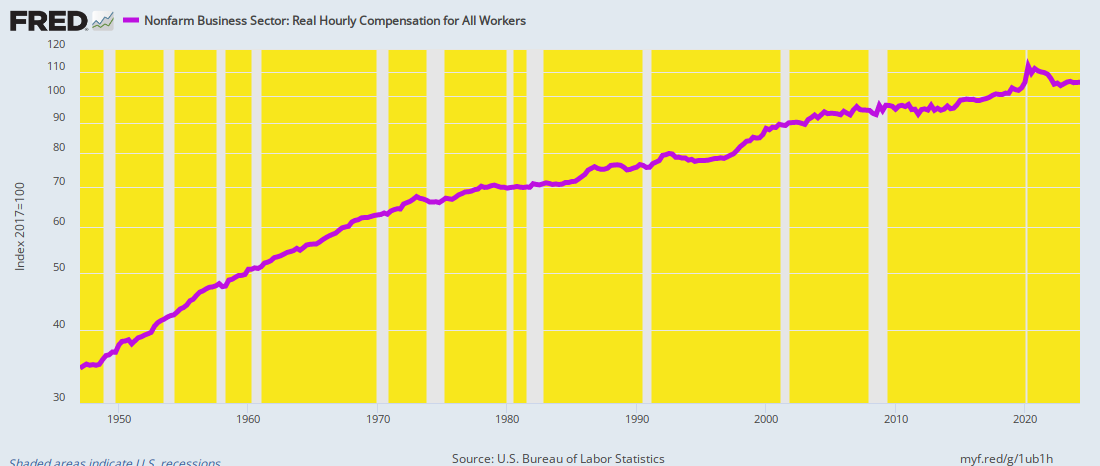There is only one way to rescue America’s faltering economy and that’s the wholesale abandonment of Washington’s reckless spending, borrowing and printing policies of the last quarter century. These policies did not remotely attain their ostensible goals of more growth, more jobs and more purchasing power in worker pay envelopes. What they did do, of course, was to freight down the main street economy with crushing debts, dangerous financial bubbles, chronic inflation and stagnating living standards.
For want of doubt, go straight to the most basic economic metric we have—real compensation per labor hour. The latter metric not only deletes the inflation from the pay figures, but also measures the totality of worker compensation, including benefits for health care, retirement, vacation, disability, sick leave and other fringes.
Needless to say, the purple line below makes crystal clear that historic worker gains have ground to a complete halt.
Per Annum Increase In Real Hourly Compensation:
Q1 1947 to Q1 2001: +1.79%.
Q1 2001 To Q1 2020: +0.71%.
Q1 2020 to Q2 2024: -0.01%.
It doesn’t get any cleaner than this. No matter how the White House, the Fed and the fawning financial press cherry pick the “incoming data” you flat-out can’t say the US economy is “strong” when the growth of the inflation-adjusted pay envelope of 161 million workers has deflated to the vanishing point. Indeed, it has literally been dead in the water for the last 52 months running.
Real Nonfarm Worker Compensation per Hour, 1947 to 2024
Moreover, the above graph covers all workers, from the bottom to the top end of the wage scale. But when you look at the most recent trends for the highest paid jobs in the durable goods manufacturing sector, the stagnation has been even more dramatic. There has been zero net gain in real compensation per hour in this high-pay sector during the last 15 years; and an obvious contributor to that baleful outcome has been the surge of inflation since 2020 when Washington went off the deep-end with fiscal stimmies and upwards of $5 trillion of newly minted central bank credit.
And we do mean deep-end. During the one-year pandemic stimmy bacchanalia, Washington spent $6.5 trillion on a one-time basis or 150% of the regular Federal budget for war, welfare and everything else as of 2019. At the same time, the Fed printed $5 trillion of new credit during the 30 months between October 2019 and March 2022, which was more than it had printed during the first 106 years of its existence!
Keep reading with a 7-day free trial
Subscribe to David Stockmans Contra Corner to keep reading this post and get 7 days of free access to the full post archives.



